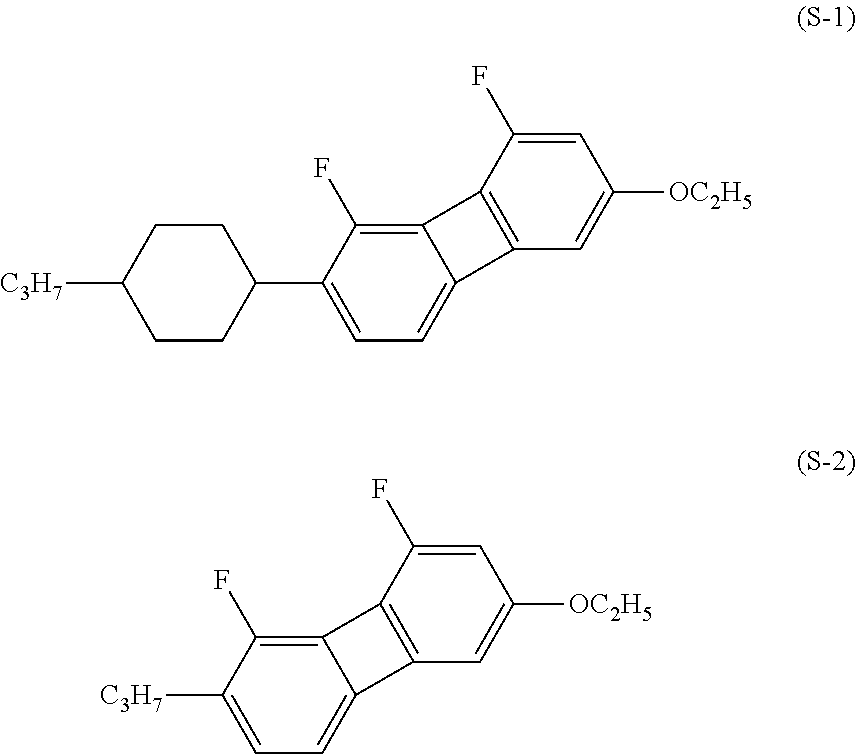Liquid crystal compound having biphenylene, liquid crystal composition and liquid crystal display device
a liquid crystal compound and biphenylene technology, applied in non-linear optics, instruments, organic chemistry, etc., can solve the problems of shortening the response time and reducing the cell thickness of the devi
- Summary
- Abstract
- Description
- Claims
- Application Information
AI Technical Summary
Benefits of technology
Problems solved by technology
Method used
Image
Examples
synthesis example 1
Synthesis of Compound (1-1-11)
[0196]
First Step: Synthesis of Compound (T-2)
[0197]Under a nitrogen atmosphere, compound (T-1) (50.0 g), potassium carbonate (66.1 g) and DMF (350 mL) were put in a reaction vessel, and the resulting mixture was stirred at 80° C. for 30 minutes. Thereto, iodoethane (29.2 mL) was added dropwise, and the resulting mixture was further stirred at 80° C. for 2 hours. The resulting reaction mixture was poured into ice water, and an aqueous layer was subjected to extraction with toluene. Combined organic layers were washed with water, and dried over anhydrous magnesium sulfate. The solution was concentrated under reduced pressure, and the residue was purified by silica gel chromatography (heptane) to obtain compound (T-2) (54.3 g, yield: 96%).
Second Step: Synthesis of Compound (T-4)
[0198]Under a nitrogen atmosphere, compound (T-3) (50.0 g), potassium carbonate (72.4 g) and DMF (350 mL) were put in a reaction vessel, and the resulting mixture was stirred at 80°...
synthesis example 2
Synthesis of Compound (1-2-43)
[0204]
First Step: Synthesis of Compound (T-7)
[0205]Compound (T-7) (67.7 g, yield: 86%) was obtained by using compound (T-6) (62.3 g) prepared according to a publicly known method in place of iodoethane in a manner similar to the technique in the first step in Synthesis Example 1.
Second Step: Synthesis of Compound (T-8)
[0206]Compound (T-8) (56.1 g, yield: 98%) was obtained by using Iodoethane in place of 1-bromopentane in a manner similar to the technique in the second step in Synthesis Example 1.
Third Step: Synthesis of Compound (T-9)
[0207]Compound (T-9) (21.9 g, yield: 54%) was obtained by using compound (T-7) (25.0 g) and compound (T-8) (47.3 g) as a raw material in a manner similar to the technique in the third step in Synthesis Example 1.
Fourth Step: Synthesis of Compound (1-2-43)
[0208]Compound (1-2-43) (1.12 g, yield: 7.1%) was obtained by using compound (T-9) (21.9 g) as a raw material in a manner similar to the technique in the fourth step in Syn...
use example 1
[0216]
3-H1OBip(F3)-O2(1-2-43)2%2-HB-C(15-1)8%3-HB-C(15-1)11%3-HB-O2(2-5)14%2-BTB-1(2-10)3%3-HHB-F(13-1)3%3-HHB-1(3-1)8%3-HHB-O1(3-1)5%3-HHB-3(3-1)12%3-HHEB-F(13-10)5%5-HHEB-F(13-10)3%2-HHB(F)-F(13-2)5%3-HHB(F)-F(13-2)8%5-HHB(F)-F(13-2)7%3-HHB(F,F)-F(13-3)6%
PUM
| Property | Measurement | Unit |
|---|---|---|
| Temperature | aaaaa | aaaaa |
| Fraction | aaaaa | aaaaa |
| Fraction | aaaaa | aaaaa |
Abstract
Description
Claims
Application Information
 Login to View More
Login to View More - R&D
- Intellectual Property
- Life Sciences
- Materials
- Tech Scout
- Unparalleled Data Quality
- Higher Quality Content
- 60% Fewer Hallucinations
Browse by: Latest US Patents, China's latest patents, Technical Efficacy Thesaurus, Application Domain, Technology Topic, Popular Technical Reports.
© 2025 PatSnap. All rights reserved.Legal|Privacy policy|Modern Slavery Act Transparency Statement|Sitemap|About US| Contact US: help@patsnap.com



